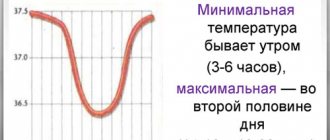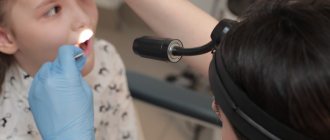A dry cough and elevated body temperature are reasons to suspect you have coronavirus. Scientists continue to study the symptoms, features of the course and possible complications of the new disease. Available data on changes in body temperature during coronavirus make it possible to clearly formulate indicators characteristic of the asymptomatic course of the disease, mild and severe.
The main reasons for a temperature of 40 °C
The most common cause of an increase in body temperature to 40 degrees is acute respiratory viral infections1,4. They are also accompanied by cold symptoms: runny nose with liquid mucous discharge and/or impaired nasal breathing, sore throat, discomfort and sometimes sore throat. Possible hoarseness, cough, and congestion in the ears. This condition can occur almost simultaneously with a rise in temperature to 40 degrees or some time later - this happens, for example, with the flu. Fever in such respiratory infections is a sign of an active fight of the immune system against the invading pathogen1,2,4.
An increase in temperature below 40 °C during viral diseases is also due to the addition of a secondary bacterial infection. This can lead to the development of complications such as tracheobronchitis, pneumonia, sinusitis, otitis media, tonsillitis (tonsillitis)2.
Up to contents
Flu and fever
When describing the characteristic signs of influenza, patients and medical workers first of all note high temperature as a typical symptom of the disease: it quickly “grows” to high numbers and persists even against the background of antipyretic drugs. “What a shame - I’m sick!” - a workaholic with aching muscles, headache and severe weakness may exclaim. He will exclaim and begin feverishly to “bring down” the temperature using any available means in order to get rid of the infection in 2 days and continue to perform work feats.
He does not yet know that Canadian scientists have already conducted a study on the massive use of antipyretic drugs during the flu epidemic. And they came to the conclusion that such “treatment” only contributes to the spread of infection. Why?
Yes, because any person infected with the flu begins to spread the virus. But if he stops closely communicating with other people, takes sick leave and begins treatment, then the likelihood of “sharing” the virus decreases. The workaholic continues to lead a normal life and thinks that he was able to “deceive the system.”
Fever is a natural reaction of the body in response to infectious (bacteria, viruses) or non-infectious causes. The mechanism of hyperthermia is associated with an increase in heat production and limited heat transfer. The hypothalamus, adrenal glands, and thyroid gland play an important role in regulating body temperature. Its increase against the background of infectious diseases occurs due to the action of pyrogen substances, which are the decay products of viruses or bacteria, and body proteins.
The classification of fevers is based on the degree of increase in body temperature:
- subfebrile - temperature up to 38 ° C;
- febrile - temperature from 38 °C to 39 °C;
- pyretic - temperature from 39 °C - 41 °C,
- hyperpyretic - the temperature exceeds 41 °C.
Fever during influenza is subjectively difficult to tolerate, but it speeds up the basal metabolism by 1.5 times and activates the body’s defenses:
- stimulates antibody synthesis;
- inhibits the reproduction and spread of the virus;
- enhances the bactericidal properties of blood;
- accelerates the neutralization of toxins by the liver;
- activates kidney function.
Explaining how the body fights the influenza virus, infectious disease specialists note that an increase in temperature to 38-38.5 °C is “sufficient” to activate defenses and begin to destroy the infection. With such values, adults and children, as a rule, cope with the manifestations of the disease themselves and do not need to take antipyretics. Virus replication is stopped. Against the background of high temperature, the vessels dilate, and more immunoglobulins come to the site of infection with the blood. These are proteins that “pick up” infectious agents and, as part of immune complexes, are removed from the body. This way a person gets rid of the flu virus faster and recovers.
An increase in temperature to 39 °C or more can already cause harm to the body - the nervous, respiratory, and cardiovascular systems suffer.
What is the danger of a temperature of 40 ° C?
A temperature of 40 degrees is a very dangerous symptom. Such severe fever is accompanied by increasing general dehydration, negatively affects the functioning of all internal organs and leads to severe overload of the cardiovascular system. The consequence of such stress for the body can be acute heart failure and other conditions (especially in elderly patients)1.
A temperature of 40 degrees can also provoke swelling of the nervous tissue with subsequent cerebral edema1. Symptoms of this process are a variety of neurological disorders and depression of consciousness1. Sometimes with such a fever, hallucinations appear and the patient begins to delirium.
In a child, a temperature of 40 °C can lead to seizures3,4,5. This is what makes it especially dangerous for children with neurological disorders.
Up to contents
When should you call an ambulance?
At such a high temperature you should always call an ambulance. This should be done as soon as one or more of the following symptoms appear:
- excessive drowsiness, obvious lethargy, disorientation;
- hallucinations, delusions;
- severe shortness of breath, chest pain, blue discoloration of the nasolabial triangle, heart rhythm disturbances;
- stomach ache;
- increasing dehydration, which is indicated by a decrease in skin moisture, dry tongue and sclera, a significant decrease in the amount of urine;
- rash;
- lack of effect from taking antipyretics, maintaining the temperature at 40 ° C or even increasing it3,4,5.
It is also recommended to call an ambulance if a fever develops in a child with neurological diseases. Emergency consultation with a doctor is also necessary for patients with immunodeficiency and elderly patients.
Up to contents
Why is it dangerous when the temperature rises above 38°C?
If a high temperature occurs, then this is a sure sign of a sharply worsening pathology. In 99% of cases this is an inflammatory process. If the condition is long-term, it means that the malfunction in the body is serious, so you cannot do without qualified medical care. The patient's body reacts to the infection by stimulating the immune system, accelerating metabolism, producing antibodies, and increasing blood circulation.
At this time, microbes lose activity, but the respiratory and cardiac systems bear an increased load. The nervous system takes a hit, the body loses water. If the condition does not change, the temperature remains, then blood circulation in the internal organs will deteriorate. The most dangerous stage is when the indicator rises above 41°C. Before the doctor arrives, the patient must take antipyretics for fever.
Is it necessary to lower the temperature to 40°C?
If the temperature has risen to 40 °C, it must be brought down, regardless of the well-being of the sick person and his age3,4,5. However, one should not strive for rapid and complete elimination of fever. To begin with, it will be enough to lower the temperature from 40 to 38–38.4 °C. Only if fever is poorly tolerated, neurological disorders and other complications develop, they try to immediately reduce it to 37–37.5 °C. The fact is that a very sharp decrease in temperature to a normal level can aggravate cardiovascular failure, which inevitably makes itself felt at a temperature of 40 degrees3.
Up to contents
What should you do at a temperature of 40 °C?
It is recommended to take age-appropriate medications with antipyretic properties, stay in bed for at least 3-4 days, drink plenty of warm liquids and avoid overheating3,4,5. Do not forget that in most cases such fever is caused by infection. Therefore, it is necessary to take measures to prevent infection of other family members. Relatives of the sick person are advised to ventilate the room, use separate dishes from the sick person, wear masks, wash their hands frequently and carry out wet cleaning.
Up to contents
Temperature 40 °C in a child
A child with a temperature below 40 °C can be a symptom of many diseases4. Moreover, not all of them can be correctly diagnosed during the initial examination. For example, severe kidney and urinary tract infections can mimic the pathology of the digestive system. After all, in a child they are often accompanied by abdominal pain, nausea and vomiting against a background of a temperature of 40 degrees. And the initial stage of measles is very similar to respiratory viral diseases.
Such a high fever must be brought down, even if the child has a temperature of 40 ° C without symptoms of damage to internal organs4,5. He should be given a doctor-approved antipyretic drug, following the recommended age-specific dosage4,5. Preference is usually given to drugs in soluble form or in syrup form, which makes swallowing easier and speeds up the process of absorption of the drug in the digestive tract. In consultation with the pediatrician, it is permissible to use non-drug measures to increase heat transfer from the surface of the skin.
You cannot give your child antibiotics on your own4,5. The decision on this method of treatment can only be made by a doctor if the temperature rises to 40 °C due to a bacterial infection. For viral diseases, antibiotics are simply useless.
The lack of effect from taking antipyretics, signs of depression of the central nervous system, the development of convulsions and symptoms of obvious dehydration in a child are reasons for urgently consulting a doctor and deciding on hospitalization4.
Up to contents
How to normalize temperature
The first aid to a person with a high body temperature should be the air he breathes. The optimal parameters for the patient's respiratory system are flow temperatures from 18˚C to 22˚C and humidity from 55% to 65%. This is what is more important than any medicine. Air entering the lungs replaces hot carbon dioxide molecules with cool oxygen molecules. If the patient feels chills, he needs to be dressed warmly, but he should breathe only cool and moist air.
Before taking antipyretics, you can use rubbing with cool compresses, if the patient’s condition allows, that is, when there is no trembling in the body.
Among the medications, two safe antipyretics can be distinguished:
- ibuprofen;
- paracetamol.
These components are found in all medications advertised as remedies for cold symptoms. Both medicines can be found both in the form of tablets and in the form of suppositories, as well as syrups. Children find it more pleasant to take syrup. But when vomiting prevents a person from taking the medicine, it is better to use suppositories intended for insertion into the rectum.
You can combine drugs. If paracetamol does not help bring down the temperature, you can give ibuprofen. It is important to remember that repeated use of the same drug is permissible no earlier than an hour and a half later.
A child can be given a second antipyretic, provided that an hour has passed since taking the first dose and the temperature has not dropped one degree. In this case, the second dose should consist only of another active substance. In other words, if an hour has passed after taking paracetamol and the situation has not changed, you can give an ibuprofen-based medicine.
Reasons for a temperature of 40 °C without cold symptoms
The cause of a temperature of 40 °C can be not only acute respiratory diseases and their complications. Such severe fever can be caused by:
- severe intestinal infections of viral or bacterial origin;
- a focus of purulent infection in peripheral soft tissues, chest or abdominal cavity, internal organs;
- sepsis;
- meningitis;
- pneumonia;
- consequences of toxic, ischemic or traumatic damage to the deep structures of the brain, accompanied by disruption of the functioning of the thermoregulation center;
- malaria (testing for this disease is mandatory for repeated episodes of a sharp increase in temperature up to 40 ° C with chills).1,2,4,5
There are many diseases that can occur with severe fever. And only a doctor can diagnose them. Therefore, if the temperature rises to 40 °C, you should not self-medicate; you should consult a specialist.
Up to contents
What can cause a fever?
So, first, let's figure out what low-grade fever is. In the literature, this is what is called a temperature above 37.4, but below 38 degrees, although more often this concept means a fever that “hovered” at the numbers 37.3 - 37.7, and we are not talking about a one-time increase in temperature, but about regular disturbances in the temperature curve. Another feature of low-grade fever is that most often a person does not feel his temperature, that is, he does not have the symptoms that we often experience when the numbers increase:
- headache;
- chills or fever;
- aching bones;
- weakness;
- sweating
He may feel well, go to work, live a normal life and experience only weakness and malaise. Often a person finds out about his low-grade fever by accident when he decides to take his temperature.
RINZA® and RINZASIP® with vitamin C at a temperature of 40 °C
Treatment at a temperature of 40 degrees includes etiotropic (aimed at eliminating the cause) and symptomatic (to reduce the severity of symptoms) therapy. And drugs with antipyretic effects play a key role. At the same time, according to the recommendations of the WHO (World Health Organization), preference should be given to drugs based on paracetamol4.
RINZA® tablets and powder for preparing an oral solution RINZASIP® with vitamin C are modern products that can be used as symptomatic therapy for acute respiratory diseases with fever in adults and adolescents over 15 years of age, as well as for children over 6 years of age (for drug RINZASIP® for children)6,7,8. They have an antipyretic effect, help relieve headaches, muscle pain and sore throat, and also reduce nasal congestion and swelling6,7,8.
Up to contents
The information in this article is for reference only and does not replace professional advice from a doctor. To make a diagnosis and prescribe treatment, consult a qualified specialist.
Literature:
- Maltseva L.A. Pyrexia and antipyretic therapy in patients with critical conditions. // Maltseva L.A., Mosentsev N.F. / Emergency Medicine, No. 4 (91), 2021, p. 51-56.
- A.N. Smirnov. Differential diagnosis of hyperthermia in non-infectious pathology. Part 2. / A.N. Smirnov, E.P. Pogorelskaya // Archives of Internal Medicine. No. 6(14), 2013; With. 53-58.
- L.I. Kalyuzhnaya. Heat disturbances and fever. / L.I. Kalyuzhnaya, D. A. Zemlyanoy // Pediatrician volume VI No. 1 2015, p. 124-133.
- Yu. B. Belan. Fever in pediatric practice. / Yu. B. Belan, M. V. Starikovich // Attending physician. No. 10/13, 2013.
- Delyagin V. M. Fever. The variety of reasons and the complexity of the solution / To help the pediatrician. No. 1 2013, p. 80-83.
- Instructions for use of the drug RINZA®. Registration number: P N015798/01.
- Instructions for use of the drug RINZASip® with VITAMIN C. Registration number: LS-002579.
- Instructions for use of the drug RINZA® for children. Registration number: LP-001821.










